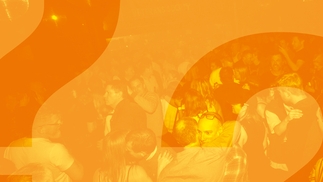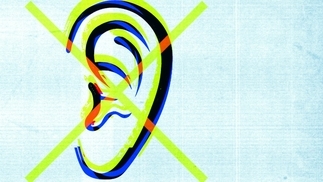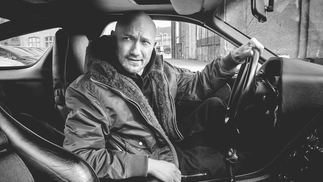A TRIBE CALLED RED: TRIBAL GATHERING
Mashing up musical styles and sampling indigenous culture
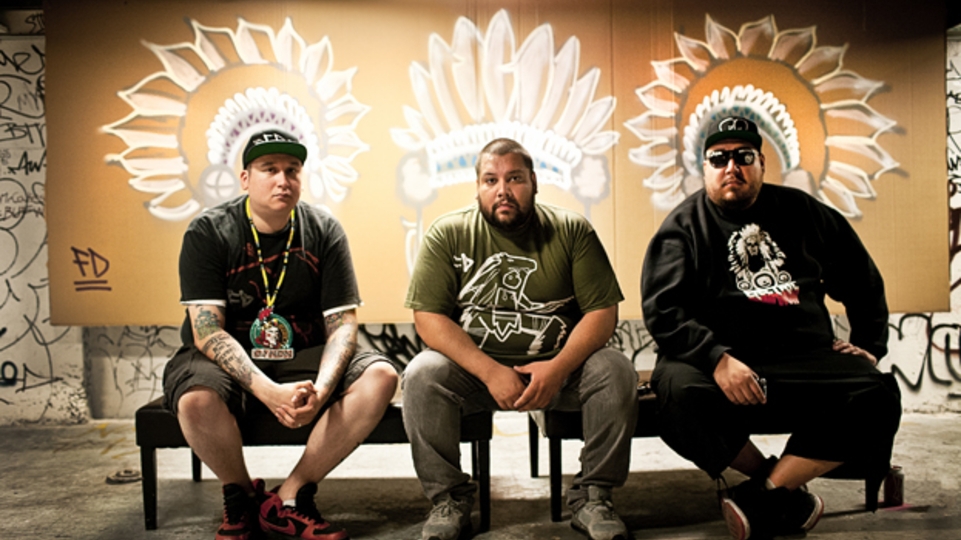
Mashing up musical styles and sampling indigenous culture, A Tribe Called Red are one of the most exciting, important and downright dangerous DJ trios around at the moment, thinks Carl Loben. 2014 is going to be their year...
Moombahton’s mix of electro and reggaeton could almost have been tailor-made for A Tribe Called Red. The bastardisation of Dirty Dutch house and reggaeton — first brought about by US DJ Dave Nada slowing down Afrojack’s remix of Chuckie & Silvio Ecomos ‘Moombah’ — is like the synthesis of the musical tastes of Deejay NDN and Bear Witness from ATCR. NDN is the electro guy, while Bear grew up on reggae, dancehall and jungle — “anything with that ragga vibe,” he says.
Both Bear and NDN originally hail from the Cayuga tribe in Ontario, and they met while both working in a club in Ottawa. When DMC turntablist champ DJ Shub visited, a hip-hop freak, they hit it off immediately and asked him to stay.
Initially the trio were called something else, but they renamed themselves A Tribe Called Red after soul-searching internal discussion. “A Tribe Called... whatever reserve they’re from is used by a lot of First Nation communities, like the drum groups that come off the reserves,” explains NDN. “So when we chose our name, it was something that was recognisable to the rural First Nations — and also, with the obvious A Tribe Called Quest reference, to the urban natives. We felt it was something that appealed to everyone.”
“Also, red is the colour that represents indigenous people,” adds Bear. “It’s something inclusive of all indigenous peoples of North America. By the time we were choosing that name, we had already gotten this reaction from this community, where people were telling us that this was something important, that this was something that they wanted and needed, and that we had to continue doing.”
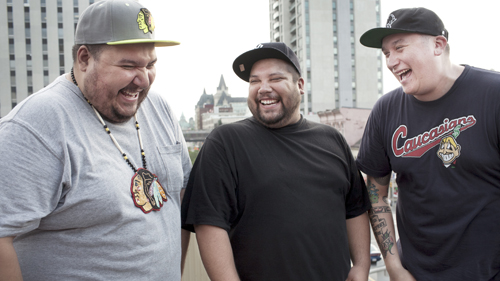
EMPOWERING
ATCR don’t just rock the party, but they bring in samples and visuals from Native cultures to add a thought-provoking element to their performance. Some of these are powerful tribal chants or bone-rattling medicine drum stomps, or samples from Hollywood films and Westerns portraying Native peoples as ignorant savages. Bear video-mixes images from films and re-contextualises them, reclaiming misrepresentative images of Aboriginal people and turning them into something empowering. The result is immense.
Most people think of Canada as quite a progressive, liberal country, perhaps even more so than its downstairs neighbours the United States when you take out NYC and San Fran. But Canada has some dark secret history to do with the genocide of indigenous peoples by white European colonialists — just as much as the United States has. “The reason you know so much more about the United States is that it’s more blatant,” NDN tells DJ Mag. “In Canada it’s more underhand, it’s always been that way, and in a lot of ways it makes it a lot worse cos it’s not talked about, it’s not evident.”
“Once the United States was formed, that’s when the so-called ‘Indian wars’ started,” says Bear Witness. “Which was never really a war, it was people defending their land.
Whereas in Canada it was more insidious, it was more ‘Let’s make them a part of this, and that’s the way we’re going to continue this genocide’. You can be left behind and left out and stay true to your culture, or you can assimilate and become part of our culture. That’s the way that genocide is continued.”
The guys start talking about the last bastion of oppression of indigenous people that was happening in Canada until very recently. Kids were taken from their families and put into residential schools to be raised. “It’s never been officially written in the laws, but memos in-between offices have stated that was put into place ‘to kill the Indian in these children’,” says NDN. “The last one closed in 1996.”
“It was the last step in attempted genocide,” adds Bear. “Genocide had been going on for 500 years, since the colonisation of North America, but the colonists were unable to wipe out the indigenous people — so many things had been tried, and failed. The final step was to attack family, because family and community was what was keeping us strong.”
Within the first 100 years of colonisation, half the population of North America was wiped out. The population of Canada is now about 0.7% indigenous — about a million or so people, whose forefathers were sent to reservations after white colonialist land-grabs. “Reservations are where we were put to die,” says Bear. “We weren’t given the good places to live, it was kinda like
‘There’s a swamp over there, put them there’. It was that kinda thing. So survival on reservations was what it became about. And if all your energy is going into surviving a situation that’s meant to kill you, that’s not thriving.”
“Apartheid was modelled after the reservation system in Canada, but nobody says ‘Boo’ to that,” adds NDN. “There are still reserves in Canada. It’s turned into something that is ours now — it’s our communities, our reservations. Only in this generation now are people learning to live with pride in those places.”
Despite shining a light on Canada’s disgraceful hidden history, ATCR insist they’re not trying to be ‘political’. “It’s a responsibility, it’s something we have to do as indigenous artists,” says Bear. “It’s part of the package.” So they have a song called ‘Woodcarver’ about John T. Williams, a deaf Native American kid in Seattle who was shot by the police. But at the same time they’ll whip up their dancefloor into a psychedelic electronic melange and have the whole joint rocking by the end of their fearsomely funky set.
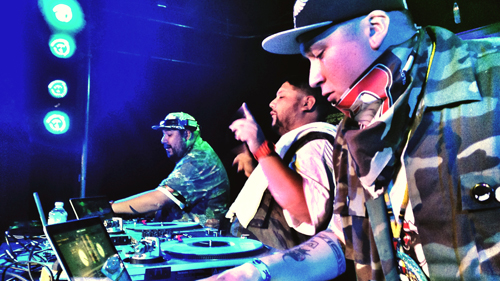
NATIVE SCI-FI
At the interview in Brighton in the afternoon, the guys start talking about Back To the Future 3 (“when Marty goes back to the Wild West in his Delorean”) and Predator (“Other than Arnold, the Native character Billy is the only one who goes toe to toe with the Predator”) and otherHollywood films such as the Buffalo Stampede from the 1930s. “The rest of it is white dudes with wigs falling off horses in buckskins, but then there’s this one scene where they go to a community and it’s all real people — a real dance troupe in real regalia doing real dances,” says Bear. This scene is ripe for sampling and looping and re-contextualising — something ATCR pull off masterfully.
DJ Mag asks ATCR what they consider the best filmic representations of indigenous peoples, and they start reeling off a list: The Fast Runner (Canadian film of Inuit tribe legend), Once Were Warriors, Dead Man and Ghost Dog — both directed by great leftfield alt.director Jim Jarmusch. Bear starts talking about how the Kevin Costner movie Dances With Wolves represented a bit of a change in the way indigenous people were represented.
“It flipped the way that indigenous people are always portrayed from bloodthirsty savage to the noble savage,” he says. “What preceded that change was a movie that Robert Redford did called Incident At Oglala, a documentary looking at what happened on Pine Ridge reservation in the ‘70s and [at] a political prisoner who’s been held now for 30 years for a crime he didn’t commit. That really started to open up this different conversation in the early ‘90s.”
There’s clearly been many discriminatory portrayals of Native peoples in films over the years, but what would ATCR do given $100m to make a movie, DJ Mag asks? Without hesitation, Bear comes back. “Native sci-fi. Sci-fi is always about colonising other planets, so what would Native sci-fi look like and entail? It wouldn’t be about going out into the universe, but about how we are connected to the rest of the universe and what our place in that system is.”
ATCR are touring their ‘Nation II Nation’ album at the moment, but you sense that the best is still to come from them in terms of recorded output. “We’re big dudes, so it’s hard to work on planes!” says Chub. “We’ve got a new album coming out in 2014 — we just have to make it!”
They’re also doing bigger shows the whole time, selling out 1000-capacity venues in Toronto and Ottawa and playing to 10,000 at the Tucson, Arizona All Souls celebration last November. “Everyone has pictures of their family members that passed away that year, honouring people that died,” outlines NDN. “There were stilt walkers, acrobats, fire-breathers all doing choreographed dances to our music — it was insane.”
ATCR will certainly rock it just as effectively in late-night club sets, say at Fabric at 3am, as they do at festivals and live shows. Get involved.
